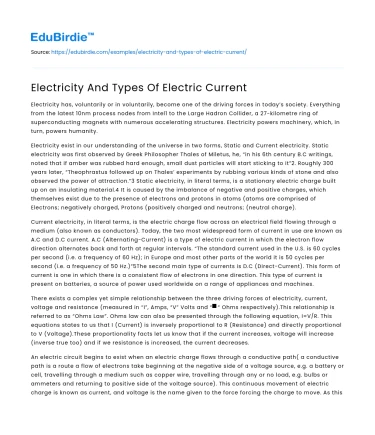Electricity has, voluntarily or in voluntarily, become one of the driving forces in today’s society. Everything from the latest 10nm process nodes from Intel1 to the Large Hadron Collider, a 27-kilometre ring of superconducting magnets with numerous accelerating structures. Electricity powers machinery, which, in turn, powers humanity.
Electricity exist in our understanding of the universe in two forms, Static and Current electricity. Static electricity was first observed by Greek Philosopher Thales of Miletus, he, “in his 6th century B.C writings, noted that if amber was rubbed hard enough, small dust particles will start sticking to it”2. Roughly 300 years later, “Theophrastus followed up on Thales’ experiments by rubbing various kinds of stone and also observed the power of attraction.”3 Static electricity, in literal terms, is a stationary electric charge built up on an insulating material.4 It is caused by the imbalance of negative and positive charges, which themselves exist due to the presence of electrons and protons in atoms (atoms are comprised of Electrons; negatively charged, Protons (positively charged and neutrons; (neutral charge).
Save your time!
We can take care of your essay
- Proper editing and formatting
- Free revision, title page, and bibliography
- Flexible prices and money-back guarantee
Current electricity, in literal terms, is the electric charge flow across an electrical field flowing through a medium (also known as conductors). Today, the two most widespread form of current in use are known as A.C and D.C current. A.C (Alternating-Current) is a type of electric current in which the electron flow direction alternates back and forth at regular intervals. “The standard current used in the U.S. is 60 cycles per second (i.e. a frequency of 60 Hz); in Europe and most other parts of the world it is 50 cycles per second (i.e. a frequency of 50 Hz.)”5The second main type of currents is D.C (Direct-Current). This form of current is one in which there is a consistent flow of electrons in one direction. This type of current is present on batteries, a source of power used worldwide on a range of appliances and machines.
There exists a complex yet simple relationship between the three driving forces of electricity, current, voltage and resistance (measured in “I”, Amps, “V” Volts and “Ω“ Ohms respectively).This relationship is referred to as “Ohms Law”. Ohms law can also be presented through the following equation, I=V/R. This equations states to us that I (Current) is inversely proportional to R (Resistance) and directly proportional to V (Voltage).These proportionality facts let us know that if the current increases, voltage will increase (inverse true too) and if we resistance is increased, the current decreases.
An electric circuit begins to exist when an electric charge flows through a conductive path( a conductive path is a route a flow of electrons take beginning at the negative side of a voltage source, e.g. a battery or cell, travelling through a medium such as copper wire, travelling through any or no load, e.g. bulbs or ammeters and returning to positive side of the voltage source). This continuous movement of electric charge is known as current, and voltage is the name given to the force forcing the charge to move. As this charge moves through the medium / conductor it will encounter friction and opposition to its motion to an extent, this occurrence is referred to as Resistance. All these processes co existing lead to them affecting each other as stated above. Overall, the amount of current depends on the extent/strength of the resistance opposing the flow of the current and the extent/strength of the voltage.
An experiment was conducted on 3 resisters during which the amount of current flowing through in the circuit after the resisters was measured alongside increasing voltage.
Prediction:
I predict that, despite the different resistance strengths (measured in Ohms/ Ω) in the 3 resisters, the current measured flowing past the resisters in all three will increase alongside the Voltage increase. This is because we know for a fact that Voltage and Current are proportionally linked, and an increase in either, will lead to an increase in the other. And since the resistance in each individual resister is not changing, the current will not decrease.






 Stuck on your essay?
Stuck on your essay?

